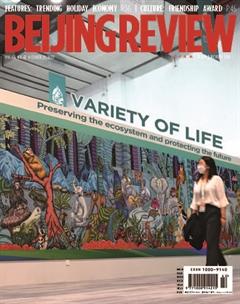KEEPERS OF THE WILD
By Tao Zihui

W hen Li Yuhan spotted a snow leopard leisurely sitting on a snow-covered mountain in the Sanjiangyuan area, glancing down at her like an emperor trying to decide if the unexpected guest was actually worth its valuable time, she suddenly understood why the big cat is known as the “king of the snowy mountains.”
About 10 minutes later, the snow leopard turned around and vanished. It obviously had no interest whatsoever in Li or the other volunteers from the Shanshui Conservation Center, a Beijing-based nongovernmental organization (NGO) that monitors local wildlife, particularly the famously elusive snow leopards which are gradually becoming a less enigmatic species to Chinese biologists.
“Seeing him made me reconsider the relationship between man and animal; we can forge a harmonious type of coexistence,” Li told Beijing Review.
In recent years, a growing number of these big cats have been captured on film as camera traps have been set up in habitats around the country by volunteers from a number of different NGOs.
Northwest Chinas Qinghai Province is one of the regions in the world that boast the highest concentration of snow leopards. Continuous efforts in the protection of the species, both from the central and local level, are finally paying off.
The snow leopard, a rare species boasting thick fur with black spots, often roams the steep, rugged terrain high up in the mountains.
The animal was first listed as an endangered species in 1986. In 2017, the International Union for the Conservation of Nature (IUCN) changed the snow leopards conservation status to “vulnerable,” following a three-year assessment.
There were between 7,446 and 7,996 of these large felines left in the wild as of 2020, according to IUCN statistics released last year.
Located on the Qinghai-Tibet Plateau, the Sanjiangyuan area, nicknamed “Chinas water tower,” is home to the headwaters of the Yangtze, Yellow and Lancang rivers, which nurture billions of lives. The area features about 1,000 of the furry cats, making it one of the worlds principal contiguous snow leopard habitats. On October 12, Sanjiangyuan National Park, also known as the Three-River-Source National Park, was listed among Chinas first national parks.
Nevertheless, all creatures living there are subject to the whims of Mother Nature as the area is sensitive to climate change.
Over the decades, generations of conservationists have fought to protect the sacred land. Twentyseven-year-old Li is one of them. As a representative to the 15th Meeting of the Conference of the Parties to the United Nations Convention on Biological Diversity (COP15), Li introduced how millions of young people in China have made a difference in the protection of endangered faunae.

